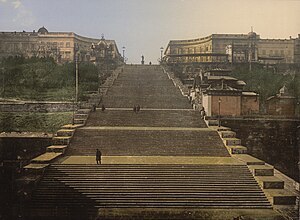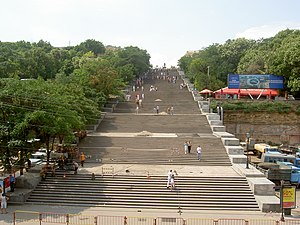Potemkin Stairs
Potemkin Stairs | |
|---|---|
| Stairs | |
| Template:Lang-uk | |
 Potemkin Stairs in Odessa, Ukraine. The higher perspective allows a person to see both the stairs and landings. | |
| Design | F. Boffo, Avraam I. Melnikov and Pot'e |
| Construction | 1837–1841 |
| Opening date | 1841 |
| Steps | 192 |
| Height | 27 m |
| Surface | granite, sandstone[1][2] |
| Location | Odessa, Ukraine |
The Potemkin Stairs (Template:Lang-uk, Potemkinsky Skhidtsi, Template:Lang-ru) is a giant stairway in Odessa, Ukraine. The stairs are considered a formal entrance into the city from the direction of the sea and are the best known symbol of Odessa.[1] The stairs were originally known as the Boulevard steps, the Giant Staircase,[3] or the Richelieu steps.[4][5][6][7] The top step is 12.5 meters (41 feet) wide, and the lowest step is 21.7 meters (70.8 feet) wide. The staircase extends for 142 meters, but it gives the illusion of greater length.[8][9][10] The stairs were so precisely constructed as to create an optical illusion. A person looking down the stairs sees only the landings, and the steps are invisible, but a person looking up sees only steps, and the landings are invisible.[1][2]
History


Odessa, perched on a high steppe plateau, needed direct access to the harbor below it. Before the stairs were constructed, winding paths and crude wooden stairs were the only access to the harbor.[1]
The original 200 stairs were designed in 1825 by F. Boffo, St. Petersburg architects Avraam I. Melnikov and Pot'e.[1][2][11] The staircase cost 800,000 rubles to build.[1]
In 1837 the decision was made to build a "monstrous staircase", which was constructed between 1837 and 1841. An English engineer named Upton constructed the stairs. Upton had fled Britain while on bail for forgery.[12] Greenish-grey sandstone from the Austrian port of Trieste (now in Italy) was shipped in.[1][2][13]

As erosion destroyed the stairs, in 1933 the sandstone was replaced by rose-grey granite from the Boh area, and the landings were covered with asphalt. Eight steps were lost under the sand when the port was being extended, reducing the number of stairs to 192, with ten landings.[1][2]
The steps were made famous in Sergei Eisenstein's 1925 silent film The Battleship Potemkin.
On the left side of the stairs, a funicular railway was built in 1906 to transport people up and down instead of walking. After 73 years of operation (with breaks caused by revolution and war), the funicular was replaced by an escalator in 1970.[2] The escalator was in turn closed in 1997 but a new funicular was opened on 2 September 2005.[13]
After the Soviet revolution, in 1955, the Primorsky Stairs were renamed as Potemkin Stairs to honor the 30th anniversary of the mutiny on the Battleship Potemkin.[14] After Ukrainian independence, like many streets in Odessa, they name returned to the stairs' original name, Primorsky Stairs. Most Odessites still know and refer to the stairs as their Soviet name.[13]
Duke de Richelieu Monument

At the top of the stairs is the Duke de Richelieu Monument, depicting Odessa's first Mayor. The Roman-toga figure was designed by the Russian sculptor, Ivan Petrovich Martos (1754-1835). The statue was cast in bronze by Yefimov and unveiled in 1826. It is the first monument erected in the city.[15][16][17]
Quotes
A flight of steps unequalled in magnificence, leads down the decivity to the shore and harbour[18]
This expensive and useless toy, is likely to cost nearly forty thousand pounds.[19]
One of the great sights of Odessa is the staircase street that extends from the harbor shore to the end of the fine boulevard at the top of the hill. Seeing it, don't you involuntarily wonder why such an idea is not oftener carried out? The very simplicity of the design gives it a monumental character; the effect is certainly dignified and majestic. It would be no small task to climb all those stairs. Twenty steps in each flight, ten flights to climb, we should be glad of the ten level landings for breathing space before we reached the top of the hill.[20]
From the centre of the Boulevard, a staircase called the "escalier monstre" descends to the beach. The contractor for this work was ruined. It is an ill-conceived design if intended for ornament; its utility is more than doubtful and its execution defective, that its fall is already anticipated. An Odessa wag has prophesied that the Duc de Richelieu, whose statue is at the top, will be the first person to go down it.[21]
Viewed from one side, the figure [Duke de Richelieu Monument] seems so miserable that wags claim that it seems to be saying "'Give money here'"[22]
Seen from below the vast staircase [the Duke de Richelieu Monument] "appeared crushed" and, the statue should have been of colossal dimensions or else it should have been placed elsewhere.[23]
Notes


- ^ a b c d e f g h Herlihy, Patricia (1991) [1987]. Odessa: A History, 1794-1914. Cambridge, MA: Harvard University Press. ISBN 0916458156, hardcover; ISBN 0916458431, paperback reprint. p. 140
- ^ a b c d e f Kononova, G. (1984). Odessa: A Guide. Moscow: Raduga Publishers. p. 51 Cite error: The named reference "guide" was defined multiple times with different content (see the help page).
- ^ Karakina, Yelena; Tatyana Samoilova; Anna Ishchenko (2004). Touring Odessa. BDRUK. ISBN 9668137019.
{{cite book}}: External link in|title= - ^ Prince Michael Vorontsov: Viceroy to the Tsar. McGill-Queen's Press - MQUP. 1990. ISBN 0773507477. p. 119. Referencing USSR: Nagel Travel Guide Series. New York: McGraw Hill. 1965. p. 616
- ^ Montefiore, S Sebag (2001). The Prince of Princes: The Life of Potemkin. St. Martin's Press. ISBN 0312278152. p. 498 "The Richelieu Steps in Odessa were renamed the "Potemkin Steps"...
- ^ Woodman, Richard (2005). A Brief History Of Mutiny: A Brief History of Mutiny at Sea. Carroll & Graf Publishers. ISBN 0786715677. p. 223
- ^ Herlihy, p. 140 "12.5 meters wide and 21.5 meters wide"
- ^ Kononova, p. 51 "12.5 m at the top and 21.6 m at the bottom"
- ^ Karakina, p. 31 "13.4 and 21.7 meters wide"
- ^ Kononova confusingly writes on page 48, "The idea of an architectural ensemble with a broad flight of stone steps leading to the sea which links the high bank with the low shore and provides a gateway to the city, belongs to the well-known St. Petersburg 19th century architect Avraam Melnikov." But on page 51 writes, "The famous Potemkin stairs leading from the square to the sea and Uiltsa Suvorova (Suvorov St.) was designed in 1825 by F. Boffo".
- ^ Reid, Anna (2000). Borderland: A Journey Through the History of Ukraine. Westview Press. ISBN 0813337925. p. 61
- ^ a b c "Primorsky (Potemkin) Stairs". 2odessa.com. Retrieved 2006-08-02.
- ^ Karakina, p. 31
- ^ "Duke de Richelieu Monument". 2odessa.com. Retrieved 2006-08-02.
- ^ Kononova, p. 48
- ^ Herlihy, p. 21
- ^ Herlihy, p. 140, Quoting Koch, Charles (1855). The Crimea and Odessa: Journal of a tour. London.
{{cite book}}: CS1 maint: location missing publisher (link) p. 260. - ^ Herlihy, p. 140, Quoting Hommaire de Hell, Xavier (1847). Travels in the Steps of the Caspian Sea, the Crimea, the Caucasus, etc. London. p. 10.
- ^ Emery, Mabel Sarah (1901). Russia Through the Stereoscope: A Journey Across the Land of the Czar from Finland to the Black Sea. Underwood & Underwood. p. 210
- ^ Herlihy, p. 140, Quoting Jeese, William (1841). Notes of a Half-Pay in Search of Health: Russia, Circassia, and the Crimea, in 1839-1840. 2 vols. London. volume 1, p. 183.
- ^ Herlihy, p. 317, Quoting William Hamm, 1862, p. 95-96.
- ^ Herlihy, p. 317, paraphrasing Shirley Brooks, 185, p. 18.
See also
- Depaldo stone stairs
- FC Chornomorets Odessa
- The Filatov Institute of Eye Diseases & Tissue Therapy
- Odessa
- Odessa Opera Theater
- Seventh-Kilometer Market
External links
- Kononova, G. (1984). Odessa: A Guide. Moscow: Raduga Publishers.
- "Primorsky (Potemkin) Stairs". 2odessa.com. Retrieved 2006-07-30.
